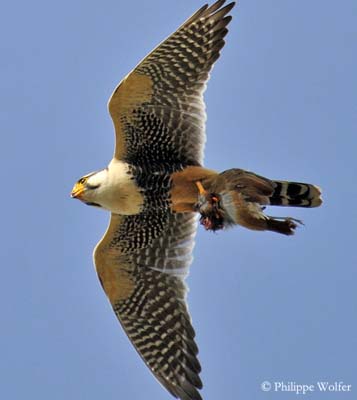
Fr: Faucon aplomado
All : Aplomadofalke
Esp : Halcón Aleto
Ital : Falco Aplomado
Nd : Aplomado-valk
Sd : Aplomadofalk
Port : Falcão-de-coleira
Photographers :
Eduardo Andrés Jordan
MIS AVES – AVES DE ARGENTINA
Philippe et Aline Wolfer
GALERIE
Text by Nicole Bouglouan
Sources :
HANDBOOK OF THE BIRDS OF THE WORLD Vol 2 by Josep del Hoyo-Andrew Elliot-Jordi Sargatal - Lynx Edicions - ISBN: 8487334156
A GUIDE TO THE BIRDS OF MEXICO AND NORTHERN CENTRAL AMERICA by Steve N. G. Howell, Sophie Webb - Oxford University Press - ISBN: 0198540124
A GUIDE TO THE BIRDS OF COLOMBIA by Steven L. Hilty and William L. Brown - Princeton University Press – ISBN 069108372X
The Peregrine Fund – World Centre for Birds of Prey
What Bird-The ultimate Bird Guide (Mitchell Waite)
Wikipedia (Wikipedia, The Free Encyclopedia)
Aplomado Falcon
Falco femoralis
Falconiforme Order – Falconidae Family
BIOMETRICS:
Length: M: 37-38 cm – F: 43-45 cm
Wingspan: 102-122 cm
Weight: M: 261 g – F: 407 g
DESCRIPTION:
This medium-sized falcon is named “aplomado” referring to the blue-grey plumage (lead-coloured). It is not usual to employ a Spanish name, and the English translation could be “Leaden Falcon”.

Both sexes are similar, but female is larger than male.
Adults have slate blue-grey upperparts with finely white-edged feathers. The flight feathers are blackish. The relatively long tail is blackish, finely barred with five white bands and tipped white.
On the underparts, the breast is white. Belly is crossed by a broad blackish streaked white band. Vent, undertail-coverts and thighs are rufous. Underwing is dark grey barred white. Undertail as above.
On the head, forehead, crown and nape are slate grey. We can see a whitish supercilium extending from the rear-eye to the buffy-white nape, and below, a slate-grey band ending on the head sides. Cheeks and throat are white, separated by a dark malar stripe.
The hooked bill is grey-black with yellow cere. Eyes are dark brown with yellow eye-ring. Legs and feet are yellowish.

Juvenile has brown upperparts and cinnamon-brown underparts, with streaked breast.


Immature has blackish-brown upperparts, and whiter eye-stripe, breast and belly.
We find three subspecies:
F.f. femoralis
F.f. septentrionalis is larger and paler.
F.f. pichinchae is darkest and larger, with incomplete breast band.
VOICE: SOUNDS BY XENO-CANTO
The Aplomado Falcon utters screams “keeh-keeh-keeh” or “ee-ee-ee-ee”. It also gives a single, sharp “keeh” or “kiih”.
HABITAT:
The Aplomado Falcon frequents grasslands, savannahs and open country, shrubby steppes and marshy areas with scattered trees.
It is visible from the moist tropical lowlands to Altiplano and puna in the Andes. In Tierra del Fuego, it frequents similar habitats and occurs up to 4000 metres of elevation.

RANGE:
The Aplomado Falcon is found from Mexico and Central America, throughout South America to Tierra del Fuego.
The extreme northern and southern populations are migratory, but the birds of Central America and Patagonia only are seasonally present.
BEHAVIOUR:
The Aplomado Falcon feeds primarily on insects, rodents and birds. It is able to catch large birds such as teals, tinamous, chachalacas, pigeons and others. It hunts for birds in the early morning and then, it spends long time hawking insects at dusk.

It usually hunts from a perch and swoops down to catch the prey.
This falcon is also known to steal food from other birds of prey, falcons and kites. It also forages at grass fires.
They often hunt in tandem, especially when hunting birds. When the male spots a distant prey from its perch, it initiates the attack and usually the female follows it. But if she does not move, the male calls her. The female may also flush out birds from bushes and pursue them while the male hovers just above.

They also hide the uneaten food for later, and they defend these sites from other birds.
The Aplomado Falcons are often seen in pairs or solitary, perched on fences, utility poles or low branches in small trees. Both mates remain together year round.
Courtship displays may last several weeks before the laying, during which the birds perform aerial displays and probably courtship feeding by male to female.
FLIGHT:
The Aplomado Falcon has long wings and performs an agile flight. It can hover when hunting, and pursue birds in flight. It is an energetic flier and it flies with powerful wing beats.
REPRODUCTION:
Breeding season varies according to the range, but often occurs in dry season, approximately between March and May.
The Aplomado Falcon does not build nest but it uses abandoned stick nests of Corvids or other raptors such as Red-tailed Hawk and Swainson’s Hawk. Such nests are placed in trees or tall shrubs.

Female lays usually 2-3 eggs. Incubation lasts about one month shared by both parents. The young birds leave the nest about 4-5 weeks after hatching. They are fed by both adults, six or more times a day.
DIET:
The Aplomado Falcon feeds mainly on birds and insects, but it also takes rodents, bats and lizards.
It hunts from perch, often in pairs. It can pursue the prey by running on the ground or flying, and hawks insects in flight.

PROTECTION / THREATS / STATUS:
The Aplomado Falcon has stable populations and even some increase may be observed, probably thanks to the deforestation which provides them more open grassy habitats.
However, several declines occur according to the range, due to changes in the habitat with cattle grazing, and important use of pesticides.
Captive breeding programs and reintroduction actions are already active in the northern parts of the range (USA and northern Mexico) by The Peregrine Fund.
